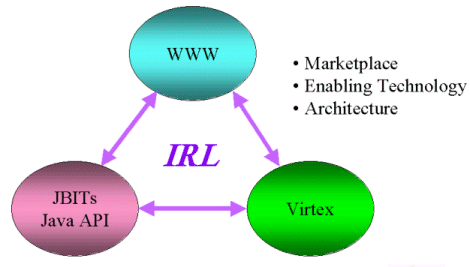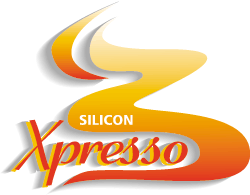Silicon
Xpressotm is a Xilinx initiative
that leverages the power and pervasiveness of the World Wide Web and the
Java programming language. The purpose of this initiative is twofold:
1. Enhance designer
productivity by providing interactive web based design tools, services,
and intellectual property. This Interactive Web (IW) design environment
takes this convenient resource, which is already established as the technical
information repository of choice, to the next level by making it a bi-directional
communications medium.
2. Provide Java based
enabling technologies to facilitate on board reprogramming of the device
for system debug, manufacturing, test, as well as after the device has
been deployed in the field. This field reprogramming covers the full
spectrum of user requirements from once-and-awhile reprogramming for the
purpose of Field Upgrades, to rapid, or run-time, reconfiguration of the
programmable logic for applications that must change either data or logic
on the fly. We call this Internet Reconfigurable Logic or IRL.
Silicon Xpresso allows
our customers to design and deliver 21st century products and take advantage
of enormous application opportunities.
If you have signed
up for Agents on our site you
can click on the following link to watch
this page for future additions to Silicon Xpresso!
Interactive
Web
Interactive Web is currently composed of four
elements. WebFitter, release 1.5i of our Alliance and Foundation
software, our new designer centric support pages http://support.xilinx.com ,
and the ASIC Estimator. These tools and services
will dramatically speed your design project and device evaluation for both
experienced and new designers of programmable logic. ,
and the ASIC Estimator. These tools and services
will dramatically speed your design project and device evaluation for both
experienced and new designers of programmable logic.
WebFitter
The WebFitter tool is a web based CPLD design fitting software tool
that allows system designers to use the latest version of Xilinx CPLD design
software and get results in minutes. With the Xilinx WebFitter tool,
there are no hardware compatibility issues, no software to download and
no hassles. Since the software application runs on Xilinx servers,
your WWW access and design files are all you need to begin fitting designs.
Xilinx will introduce this new tool beginning in Q498. Xilinx
Press Release
Alliance
and Foundation Series
As of release 1.5i (see press release),
the design manager of our Alliance Series
software and the project manager of our Foundation
Series software allow you to connect directly to our new designer centric
support pages. This instant access feature is compatible with either
Netscapetm or Microsoft Internet Explorertm web browsers
and is an important first step in creating a web based development environment
where all the tools you need to complete your project are available
quickly and easily.
Support.xilinx.com
The most heavily used pages on any semiconductor's web site are the
support pages. Xilinx has augmented the best customer support available
by providing an entire web site, http://support.xilinx.com ,
dedicated to the design engineer. Services included on this site
are news bulletins, application notes, updates, searchable knowledge base,
trouble shooting, and soon to be available online documentation.
Links include dowloadable IP, online licensing, and order inquiry. ,
dedicated to the design engineer. Services included on this site
are news bulletins, application notes, updates, searchable knowledge base,
trouble shooting, and soon to be available online documentation.
Links include dowloadable IP, online licensing, and order inquiry.
ASIC
Estimator
The ASIC Estimator
graphically compares product development costs between Xilinx FPGAs, HardWire
Arrays, and Gate Array ASIC Solutions. The program allows you to tailor
40 different parameters, such as part cost, engineering overhead, NRE charges,
etc., so that the cost models match your project development environment.
More importantly, Xilinx ASIC Estimator allows you to adjust a parameter
and immediately see the effect of the change. This allows you to quickly
explore a "what if" scenario and answer many important questions.
Internet
Reconfigurable Logic

By the end of 2002 it has been estimated that there will be 500 million
web enabled hardware devices installed (Source: International Data Corporation).
These devices will range from sophisticated multi-use appliances (like
PDAs, screen phones, PCs, and set top boxes) to standard appliances with
network connectivity and intelligence (like copiers and microwaves). Programmable
logic is uniquely suited to these devices because of its ability to be
reconfigured after it has been deployed in the field. Internet Reconfigurable
Logic (IRL) takes advantage of this enormous market opportunity caused
by pervasive networking and the WWW. IRL combines powerful Java based
APIs and advanced programmable logic devices to give designers of internet
or network appliances the ultimate in flexibility and reconfiguration options.
Network appliances designed with Xilinx software and silicon can be easily
upgraded or change functionality.
Java
API for Boundary-Scan
Sun Microsystems announced a proposed
Java Applications Programming Interface (API) for the Boundary-Scan market
to enable users, developers, silicon vendors, and platform suppliers to
easily utilize Boundary-Scan technology. announced a proposed
Java Applications Programming Interface (API) for the Boundary-Scan market
to enable users, developers, silicon vendors, and platform suppliers to
easily utilize Boundary-Scan technology.
For more information on Java API
for Boundary-Scan click
here.
JBits
The JBits API is a new Java based tool set, or application programming
interface (API), that allows designers to write information directly to
a Xilinx FPGA to carry out whatever customer logic operations were designed
for it. The JBits API permits the FPGA bitstream to be modified quickly,
allowing for fast reconfiguration of the FPGA. With Virtex FPGAs,
the JBits API can partially or fully reconfigure the internal logic of
the hardware device.
The Virtex architecture allows this reconfiguration to be as extensive
as necessary and still maintain timing information. The JBits API
also makes it possible to integrate the operations of the FPGA with other
system components such as an embedded processor, a graphics coprocessor,
or any digital peripheral device.
JBits applications, or “applets,” can use the Java API for Boundary-Scan
(unveiled by Xilinx in September) for platform independent device
configurations deployed locally or remotely over the Internet.
These applets can be control programs, consumer interface programs, or
updates. Previously, Java applets were only used to send software
updates via the Internet. The JBits API now makes its possible
to create Java logic applets that can be used to send new hardware updates
via the Internet. JBits will be available over the web in 1Q99.
* Source: International Data Corporation |




